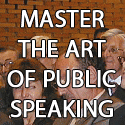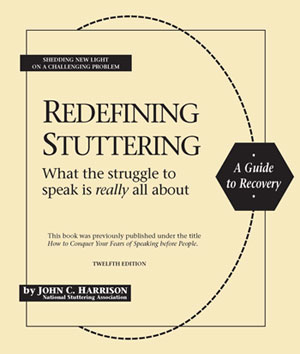Cognitive Behaviour Therapy, (CBT), is a behavioural approach to addressing thoughts and feelings that lead to anxiety, and, in the case of the person who stutters/stammers, social phobia. CBT is increasingly being used as a tool to treat stuttering/stammering, based on the premise that stuttering/stammering is aggravated by anxiety, and in many cases this anxiety level can be managed, especially if the anxiety is related purely to the belief, that the person might stutter/stammer, and what that will mean to them.
Having said all that, I do not believe that CBT is a viable approach for ALL people who stutter especially those who have severe speech blocking. I believe it is better suited to those people who I would rate as a mild stutterer (1,5 or 1,4 on the Stuttering Jack Scale of severity). That is, people who are low on the actual physical scale, but high on the psychological scale of severity. This includes what we would refer to as covert stutterers. So a person who has mild and irregular speech dysfluencies, but high psychological reactions to incidences of dysfluency, is more likely to benefit from CBT, than a person with severe and constant dysfluencies. This is an example of how it is most important, that we have some form of scale, when talking about stuttering. For to say that CBT will definitely help “stutterers”, is a misleading statement. You might be interested in reading my first two post on this subject.
Research has shown that the parts of the brain that control anxiety, are linked closely to the areas that control speech, so it is not unusual that anxiety levels effect speech fluency. Anxious thoughts that a person has about how they might be being judged by the listener, will invariably contribute to a degree of stuttering, as the focus is taken off the conversation and put onto anxiety provoking thoughts. It goes without saying, that if we can take the focus off these distracting thoughts, then they will no longer have the anxiety producing effect that they are currently having.
It must be understood, that our thoughts and feelings are so important in determining our emotional state, and the way that we see the world around us. If we want to change our behaviour, we must first look at how we are thinking. By changing the way we think about a speaking situation, we can change the experience that we have in that speaking situation. Recognising this can be a break through for some people.
CBT therapy, teaches the person who stutters to look at the thoughts that they are having and attempts to have the person see, that those toxic thoughts, invariably have no basis in fact, logic or experience, so should be negated in moving forward into the speaking situation. If thoughts can’t be negated, the aim is to learn to challenge those thoughts with a view to altering them to less anxiety provoking thoughts, when facing a particular speaking situation. Once again this is more easily achieved for mild or covert stutterers than chronic overt blockers.
The CBT practitioner, talks about the different types of thought groups that can create increased levels of anxiety. These thought groups include, unrealistic standards of social performance, unrealistic beliefs about the consequences of poor performance, and, unrealistic negative beliefs about oneself. These thoughts lead to a level of perceived negative evaluation from the listener, and, lead on to social phobia, which can be a more difficult extension of anxiety to address.
After the individual begins to understand the role that thoughts and emotions play on our feelings, and, how that effects our anxiety level, which in turn effects our degree of stuttering, he then moves onto identifying the specific thoughts, that are causing the problems to do with his own individual speech.
When a problem thought is identified like, “if I stutter people will laugh at me”, or, “if I stutter no one will employ me”, or, “if I stutter they will think I am incompetent”, or, “if I stutter they will think I am weird”, the individual is taught to challenge that thought, by asking the following eight standard CBT questions about the thought:
1) What evidence do I have that the thought is correct?
2) What evidence do I have that the thought is wrong?
3) What would I tell a friend, if they had the same thought, that would help them?
4) What would a very understanding and supportive friend say, to help me eliminate this thought?
5) Do I think I am worrying unnecessarily about something, that I have no control over?
6) How does the thought make me feel – good or bad?
7) Would there be benefits to me giving up thinking this thought?
8 ) What is the worst outcome that could occur, if this thought were true?
The individual is quite often encouraged to carry a notepad with them, and when a negative thought enters his mind, that is causing anxiety, he is encouraged to ask these questions about the thought, until he is able to consciously replace the thought, with a more resourceful thought based on evidence, and the anxious behaviour is diminished.
A CBT program generally continues to talk about how we tend to use “safety behaviours”, like avoidance, so that our feared situations do not actually occur. Through such behaviour, we are continually reinforcing our feelings about the feared situation, by instantly gratifying ourselves with reduced anxiety, from applying our own individual form of safety behaviour. CBT theory argues that unless we face our fears, we will never give ourselves the chance of seeing that our assumed outcomes of the situation, are invariably wrong, illogical and even abnormally catastrophised.
There is a natural response to the fear stimulus, that is often referred to as the “fight or flight” response. Whenever we are faced with a feeling of fear, the brain throws the body into an automatic, almost reflex response, and the natural reaction to this is invariably avoidance. This can, over time, lead to a level of social anxiety in the person who stutters. When faced with the thought that we will be judged negatively by others, it is not unusual to choose avoidance, as the easiest option. Having said that, if avoidance is not giving you the outcome that you truly desire, the best strategy to adopt, is to face your fears in these speaking situations, to discover the real outcome, rather than your imagined outcome. For it is only through facing fears, by moving outside your individual comfort zone, that fear and anxiety can ever have a chance of being reduced. It is often said in CBT that, “thoughts or predictions are NOT facts”.
Frequently, CBT involves self imagery or visualisation, where the individual is required to imagine that he is in a feared speaking situation. While in such a situation, he is asked to become aware of the images that he is producing in his head and describe what he sees, both in his own behaviour, and the behaviour of the listener. If the image is what would best be described as, “negative”, then the individual is encouraged to re-imagine the situation, in a more positive, or less negative way in an effort to override the negative experience.
CBT also seeks to address the perceptions that we have about the opinions of others. The main perception that is addressed is the perception of approval, or, disapproval. Invariably the person who stutters believes that the listener will disapprove of his stuttering. The CBT practitioner will explain that, only your thoughts can create the emotional disturbance that make you feel uneasy, as a result of a social rejection, or negative evaluation. Perceptions are within your own power to alter, and your own perceived negative evaluation only gives the listener power over you, that you have given them. If there is any actual negative evaluation, it is generally not about “you”, but more about the person doing the evaluation. The concept of “predicting”, is also addressed as we tend to predict the worst, with quite often no justification further adding to our anxiety level.
The typical CBT program then goes onto address the common issue of social perfectionism, as another form of social fear. Aiming for perfection, invariably leads to procrastination and avoidance. We can often become overly worried about what other people think of us, if we make a mistake or if we stutter, and this, once again, leads to avoidance, procrastination and excessive use of safety behaviours. Having a perfectionist approach to speech fluency, will increase anxiety and stuttering, as it makes the speaking environment very stressful. It is a useful exercise, to pretend that you are writing a letter to yourself or a friend, explaining why it doesn’t matter what other people think of you.
Social perfectionism, is addressed in CBT by encouraging the individual to deliberately make a mistake. In addressing stuttering, the mistake would be to deliberately stutter. This can be very difficult for the social perfectionist, but continuing to avoid certain speaking situations, only gives strength to the avoidance, and only by facing the situations that one avoids, without safety behaviours, will one understand that their behaviour itself, is invariably reinforcing the fears.
Another area generally addressed as part of a CBT program, is our perception of how things “should be” in our concept of the world. Are your individual perceptions resourceful to you, or not resourceful to you? Are they creating a situation where failure is inevitable, where you feel shame and frustration? As part of this process, post event analysis is quite often discussed. Are you continually going over in your mind the failures that you experience? Continually reliving your failures, only seeks to reinforce them as part of your future thoughts. Rescripting these events, to more resourceful imaging in your mind, will facilitate the brain, in remembering the preferred outcome you were really seeking.
As mentioned earlier, CBT has the possibility of being helpful for the mild or covert stutterer, who tends to catastrophise the possibility that they, “might”, have some infrequent experiences of dysfluent speech, and what that means to them. But, I believe, it will prove to be less helpful for the overt and chronic stutterer, with years of “experience”, that confirms his beliefs, about the effect of severe stuttering on himself, and his listener. This person “knows”, what will happen, and, “when” it happens, and, “how bad” it happens, and, what the outcome generally is. This is not imagined or catastrophised. It is no good telling the chronic stutterer, that his stuttering will not make a negative impression on the listener, when his life’s experience confirms his belief. It is no good telling the severe stutterer, that people will not treat him differently, if he has severe and repetitive speech blocks, when his experience confirms this belief. It is no good telling the severe stutterer, not to worry what others think, when he is really concerned more about his own judgement of himself. This is especially true if he is fluent in many situations and is able to experience the world as both a fluent and dysfluent speaker. Sometimes avoidance and other safety behaviours are a more peaceful way for the severe stutterer to live than continually putting her hand into the fire to see if she still experiences pain. CBT practitioners, working with severe stutterers, need to be reminded that stuttering is more about neural deficits in the brain, and less about cognitive processing. Having made that comment, it is fair to say that CBT is more about altering the pychological experience of stuttering, not the physical experience of speech dysfluencies, and in that regard anything that can make the experience of stuttering less painful for the stutterer, is worth giving a try.
One final comment. I do believe that CBT can be used successfully in treating severe stutterers, if it is implemented as a fluency shaping program add-on, to assist the individual, not to accept their stuttered speech, but to accept their new way of speaking, which for some, can be as hard to accept as the stuttered speech. I will talk more about this in a future post on the key aspects of conducting a successful fluency shaping program.
In the next post I will talk about NLP and Neuro-Semantics, and how they can have an equal or greater impact on the psyche of the person who stutters. In the meantime, I again urge you to subscribe to my RSS feed or email notification, so that you do not miss posts about subjects and content that you will not read anywhere else. If you found this post useful or thought provoking in any way, please make a comment.
Comments:








{ 10 comments… read them below or add one }
Would you need CBT if your stuttering went away?
Mark,
Thanks for the comment.
Well, as you are aware, that all depends on the way the treated person feels about the hold that he has on his new way of speaking that he has learned and how he feels that it sounds to him and the rest of the world. Many people feel that they have just replaced one unusual way of speaking with another somewhat unusual (to them) way of speaking. CBT could be helpful in assisitng that person to accept their new fluent way of speaking as opposed to accepting their stuttering. As I say, you would be aware that some people, not all, have trouble adjusting to their new found fluent persona and figuratively feel that a sign pops up out of their head every time they speak that says “this person is not being himself”. Do you agree?
Mark,
Thanks for the comment.
Well, as you are aware, that all depends on the way the treated person feels about the hold that he has on his new way of speaking that he has learned and how he feels that it sounds to him and the rest of the world. Many people feel that they have just replaced one unusual way of speaking with another somewhat unusual (to them) way of speaking. CBT could be helpful in assisitng that person to accept their new fluent way of speaking as opposed to accepting their stuttering. As I say, you would be aware that some people, not all, have trouble adjusting to their new found fluent persona and figuratively feel that a sign pops up out of their head every time they speak that says “this person is not being himself”. Do you agree?
Hi
I’m trying to collect some data about the efficacy of CBT with stuttering. I was just wondering if you have a rough normative data about the number of CBT sessions needed to notice a progress in speech.
Thanx 🙂
I think this information will help those who have a stuttering problem.
i do stammer and i have a habit of avoiding words and words that that begin with syllables that are hard for me to speak out. i easily get anxious when am faced with a situation where i am expected to speak. i fear making phone calls too. i wish i could be helped to handle my fears and anxiety. i would also like to know if there is a way i can manage to pronounce my difficult words. for instance, my name is irene ghadi,i find it hard to pronounce irene, i usually introduce myself as ghadi. i lookk forward to being fluent someday.
Do you happen to have any names of CBT specialist who specialize in people who stutter?
Is acceptance is a kind of CBT, because I think it focuses on changing our thoughts process about stammering. Gives us more positive perspective about stammering. Does acceptance helps in case of serve stammerers.
I enjoyed reading this article. Very informative. Thanks for sharing.
This was very valuable information. I have an undergraduate in speech and hearing sciences but I am a Professional Licensed Private Practice owner with a specialty in Anxiety and Depression. I have a new client that has severe stuttering to request my services to see if he can reduce his Trait Anxiety. I am learning and soaking up all I can. Working to give my client 110%. Thank you for this article.